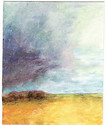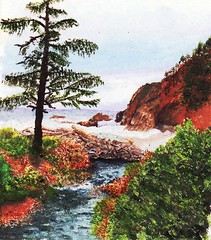Next week I'll be reviewing The Top Five Ways to Buy Miniature Art. On May 27th, the topic will be Tips on Working with a Miniature Artist on a Commissioned Work. The final segment of my planned four-week seies will be Displaying, Trading and Giving ACEOs.
When you look at any piece of art you need to know how it's been produced. Although there are many ways to make a one-of-a-kind artwork, when you are buying something called an original, it should be a piece created directly on the surface you're buying (called the support) by the artist. So you are buying, for example, a painting done by the artist with brushes and paint.

An original will generally be priced considerably higher than a print or a reproduction. Although there will be only one original, the artist retains the right to reproduce their work and sell the reproductions. If the reproductions are popular, this can actually increase the value of the original.

Today artwork can easily be reproduced digitally, even at home using a good desktop printer. These reproductionsenable more people to enjoy owning and displaying art at reasonable prices.
Giclée (pronounced "zhee-clay"), is a name for a reproduction digital source, often a scan of a painting, using ink-jet printing. They are sometimes also referred to as "fine art prints."
This is where things get confusing, because although a digital reproduction of an original artwork printed on an ink-jet printer is called a "fine art print," there is a completely other type of artwork called a "print." These are pieces that are produced from an image created on one surface (called a matrix) specifically to be transferred to another surface (called a support), usually paper, to make the finished art piece. The surface on which the artist created the original work is generally never intended for public display or sale. It is necessary that the artist be directly involved in at least preparing the matrix for these prints.
produced from an image created on one surface (called a matrix) specifically to be transferred to another surface (called a support), usually paper, to make the finished art piece. The surface on which the artist created the original work is generally never intended for public display or sale. It is necessary that the artist be directly involved in at least preparing the matrix for these prints.
Different types of prints are distinguished by the matrix, or the surface the art is created on. The nature of the matrix determines the means of image transfer. Each transfer is referred to as an impression.
 A woodcut, for example, is made from an image carved on a block of wood. A linotype uses carved linoleum. With wood or linoleum, ink is applied to the matrix with a roller, then it is pressed onto the paper support to transfer the ink in the pattern of the carved image.
A woodcut, for example, is made from an image carved on a block of wood. A linotype uses carved linoleum. With wood or linoleum, ink is applied to the matrix with a roller, then it is pressed onto the paper support to transfer the ink in the pattern of the carved image.

An etching used a metal sheet as the matrix. A lithograph is made using stone. A screen print uses fabric for the matrix.
A monotype refers to a one-of-a-kind print, often one in which the artist is applying ink to the matrix in a specific way for production of a single print, or one where the artist alters the matrix after the production of one print so no two will ever be alike.

An edition in terms of a print refers works printed from a particular plate, or original. Reproductions and prints are sometimes referred to as open editions, meaning there is no limit on the number that will be printed, and limited editions in which an original is retired after production of a pre-determined number of impressions or copies are made. These are often number as 25/50, meaning the 25th impression out of a total of 50 impressions made.
All these differences should be reflected in the prices charged for a type of artwork. Generally an original has the highest price, a limited-edition print will be priced higher than an open edition, and a print will be priced higher than a reproduction.
Buy what you feel comfortable with and enjoy your art work. If you love it, it's the perfect type of art for you.
Giclée (pronounced "zhee-clay"), is a name for a reproduction digital source, often a scan of a painting, using ink-jet printing. They are sometimes also referred to as "fine art prints."
This is where things get confusing, because although a digital reproduction of an original artwork printed on an ink-jet printer is called a "fine art print," there is a completely other type of artwork called a "print." These are pieces that are
 produced from an image created on one surface (called a matrix) specifically to be transferred to another surface (called a support), usually paper, to make the finished art piece. The surface on which the artist created the original work is generally never intended for public display or sale. It is necessary that the artist be directly involved in at least preparing the matrix for these prints.
produced from an image created on one surface (called a matrix) specifically to be transferred to another surface (called a support), usually paper, to make the finished art piece. The surface on which the artist created the original work is generally never intended for public display or sale. It is necessary that the artist be directly involved in at least preparing the matrix for these prints.Different types of prints are distinguished by the matrix, or the surface the art is created on. The nature of the matrix determines the means of image transfer. Each transfer is referred to as an impression.
 A woodcut, for example, is made from an image carved on a block of wood. A linotype uses carved linoleum. With wood or linoleum, ink is applied to the matrix with a roller, then it is pressed onto the paper support to transfer the ink in the pattern of the carved image.
A woodcut, for example, is made from an image carved on a block of wood. A linotype uses carved linoleum. With wood or linoleum, ink is applied to the matrix with a roller, then it is pressed onto the paper support to transfer the ink in the pattern of the carved image.
An etching used a metal sheet as the matrix. A lithograph is made using stone. A screen print uses fabric for the matrix.
A monotype refers to a one-of-a-kind print, often one in which the artist is applying ink to the matrix in a specific way for production of a single print, or one where the artist alters the matrix after the production of one print so no two will ever be alike.

An edition in terms of a print refers works printed from a particular plate, or original. Reproductions and prints are sometimes referred to as open editions, meaning there is no limit on the number that will be printed, and limited editions in which an original is retired after production of a pre-determined number of impressions or copies are made. These are often number as 25/50, meaning the 25th impression out of a total of 50 impressions made.
All these differences should be reflected in the prices charged for a type of artwork. Generally an original has the highest price, a limited-edition print will be priced higher than an open edition, and a print will be priced higher than a reproduction.
Buy what you feel comfortable with and enjoy your art work. If you love it, it's the perfect type of art for you.

















